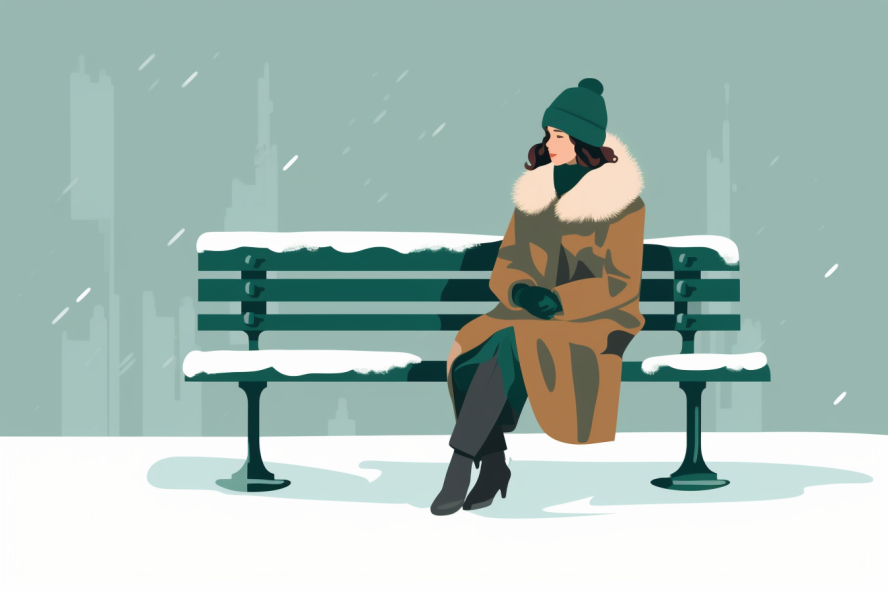
Body + Mind is reader-supported. We may earn an affiliate commission when you buy through some of the links on our site.
Depression affects millions of people worldwide. The incidence soars during winter when the days are shorter, resulting in seasonal affective disorder (SAD), a type of depression. Learn more about SAD, who are at risk of it and the various treatment methods to mitigate the symptoms.
If you live in lower latitudes or tropical locations, you’ve probably heard of SAD but aren’t so concerned about it. This makes sense because SAD affects more people living farther north and in higher altitudes. More succinctly, it’s common in countries far from the equator, where daylight hours become shorter as the end of the year approaches.
SAD is a type of depression associated with the change in season, occurring more prevalently during colder months. SAD often strikes in winter, but some people can experience it in summer. The high humidity and heat during hot temperatures drive people indoors most of the time, contributing to mood changes and depressive symptoms.
Between the two, winter-pattern SAD is more common. You’ll hear others often complain about winter blues. It describes the extreme sadness and emptiness people feel during wintertime.
Studies have shown that winter-pattern SAD occurs because of reduced levels of serotonin, a hormone that regulates mood. Experts believe the lack of access to natural light during winter due to longer nights and shorter days results in the dysfunction of molecules controlling normal serotonin volumes. This anomaly leads to hormone imbalance and SAD diagnosis.
The lack of vitamin D — which production is activated by sun exposure — also contributes to this seasonal disorder.
The common symptoms of SAD include the following:
The signs start to manifest in the late fall or early winter but disappear during spring and summer.
The swing to the colder months is a precursor of SAD. Women, people with existing mental health illnesses and those with family history of psychological disorders are at a higher risk of experiencing this problem.
Fortunately, you can manage SAD with conventional treatment methods. Here are common interventions.
This treatment uses a light box emitting 20 times brighter illumination than the indoor bulbs in your home to mimic the feel of natural sunlight. You’ll have to sit in front of the light box in the morning for 30-45 minutes to get treated. This exposure can help compensate for the reduced daylight access during darker months, helping regulate the hormones. It helps ease SAD symptoms and is considerably a more effective intervention than other control therapies.
Mental health illnesses are linked with thought patterns, and these are what you’ll work on during counseling. A therapist will help you excavate negative ways of thinking and replace them with positive ones to improve depressive symptoms.
Cognitive behavioral therapy is a type of psychotherapy that teaches one to challenge and change their unhelpful behaviors and thoughts.
Medications offer the most convenient remedy for SAD, although you’ll have to factor in the side effects. Your doctor may prescribe this remedy in combination with another therapy for a faster recovery.
It often takes 4-8 weeks for antidepressants to work and ease the symptoms. You’ll feel so much better once the effects kick in. They can also prevent recurring SAD.
Vitamin D deficiency is a common symptom among SAD patients because the skin is deprived of sunlight-induced vitamin D. Supplementation may help normalize levels in the body. Often, this nutritional approach is an adjunct to other therapies, like phototherapy and medications, to improve the efficacy of the overall treatment.
Secondary approaches to treating SAD promote holistic health. Here are other interventions to kick the blues away during winter.
Physical activities have long been known as a natural remedy for depression and other mental health conditions.
A study of 370 participants revealed that engaging in high-intensity physical exercise made them less sensitive to the effects of the changing season. Alternatively, those highly susceptible to the impact of darker months had lower psychological well-being. Going out for a run puts you in a better mood, which may help strengthen your defense against SAD.
Activities combining movement, meditation and stress reduction, like yoga and tai chi, can boost your coping skills when the season shifts. Additionally, they make you feel relaxed and reduce feelings of distress.
People with SAD experience delayed sleep timing and hypersomnolence, which is excessive daytime sleepiness. This problem happens when the circadian rhythm dysfunctions because of the low natural light levels in winter. The internal clock synchronizes with sunlight, which is used as a cue to determine day and night and regulate sleep. Rest patterns sometimes get disrupted due to the decreased daylight hours during colder months.
Talk to your doctor about restoring your usual sleep pattern. Since SAD affects each person differently, the best approach is to get personal advice.
The habits you engage in during winter are critical to your overall well-being. Practice self-care by eating healthy foods, getting enough rest, taking vitamins and increasing exposure to natural light using alternative methods.
Some people temporarily relocate to warmer locations to escape winter. Do the same if it’s an option for you. Otherwise, the best remedy is to take better care of yourself by maintaining a healthy lifestyle.
Eat nutritious foods, lace up your shoes and go for a run, get sufficient sleep and adopt strategies to reduce stress. If you’re at an elevated risk, consult your doctor about treatments. SAD affects many people, so there’s no shame in talking about it with your primary care physician and loved one. It’s highly treatable with various methods.
Your email address will only be used to send you our newsletter, and at any time you may unsubscribe. For more information, see our Privacy Policy.